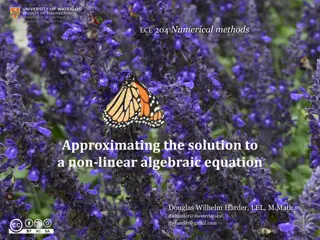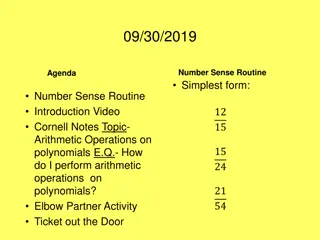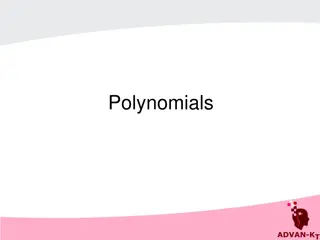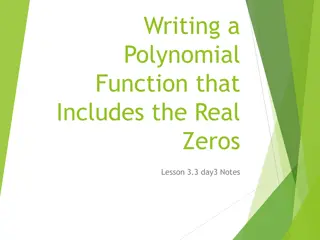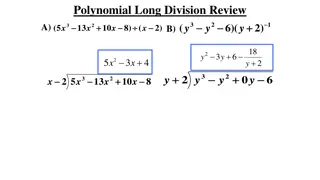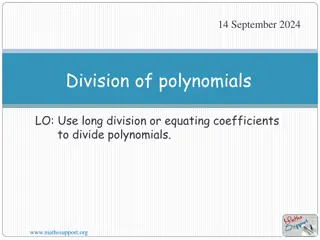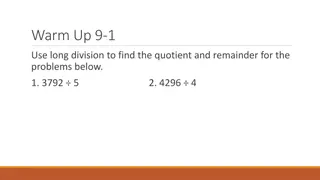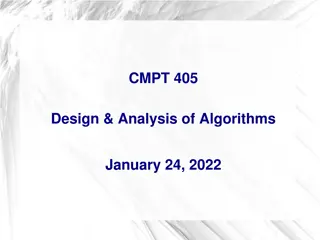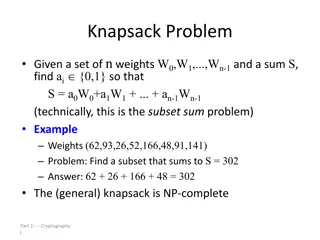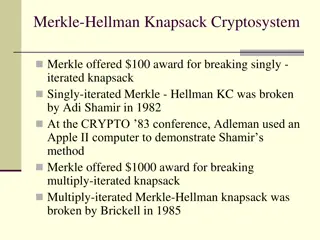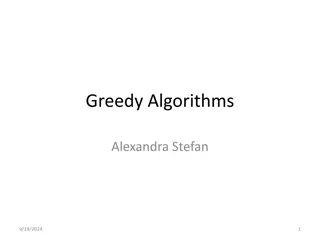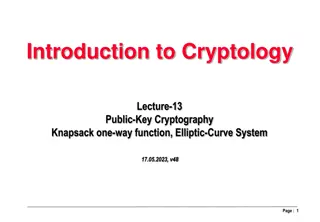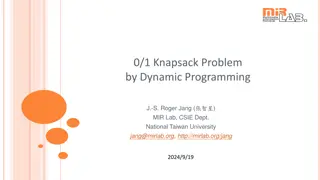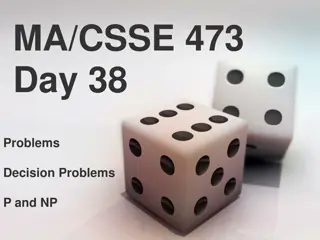Approximating Knapsack Problem in Polynomial Time
In the recent discussion, we explored approximating the Knapsack problem in fully polynomial time. By utilizing a polynomial-time approximation scheme (PTAS), we aim to find a set of items within a weight capacity whose value is within a certain range of the optimal value. This approach involves leveraging previous algorithms and optimizing the process for efficient computation.
Download Presentation

Please find below an Image/Link to download the presentation.
The content on the website is provided AS IS for your information and personal use only. It may not be sold, licensed, or shared on other websites without obtaining consent from the author.If you encounter any issues during the download, it is possible that the publisher has removed the file from their server.
You are allowed to download the files provided on this website for personal or commercial use, subject to the condition that they are used lawfully. All files are the property of their respective owners.
The content on the website is provided AS IS for your information and personal use only. It may not be sold, licensed, or shared on other websites without obtaining consent from the author.
E N D
Presentation Transcript
What did we talk about last time? Finished load balancing approximation Set cover approximation
U2 has 17 minutes to cross a bridge for a concert Plan a way to get them across in the darkness They have one flashlight A maximum of two people can cross the bridge at one time, and one of them must have the flashlight The flashlight must be walked back and forth Each band member walks at a different speed Bono: 1 minute to cross The Edge: 2 minutes to cross Adam: 5 minutes to cross Larry: 10 minutes to cross A pair must walk together at the rate of the slower man's pace
We've seen knapsack in dynamic programming (but with a pseudo-polynomial running time) We've seen knapsack as an NP-complete problem Now, can we approximate it in fully polynomial time? Recall: We have nitems Each item has a weight wiand a value vi We want to maximize total value without going over our weight capacity W
Our algorithm will take those items and the capacity Was well as a parameter We will find a set of items Swithin the weight capacity whose value is at worst 1+?of the optimal! And the algorithm will be polynomial for any particular choice of But it will not be polynomial in , if that makes sense This kind of algorithm is called a polynomial-time approximation scheme(PTAS) 1
We had a pseudo-polynomial algorithm for knapsack that ran in time O(nW) The book gives details on how we can flip around weights and values to get a dynamic programming knapsack algorithm that runs in time O(n2v*) where v* is the largest value of any item (if values are integers) Let's assume that algorithm is correct and build our approximation algorithm out of it
If v* is a small integer, then we can run the algorithm as is However, if v* is large, we can round the values up and use small integers instead: v1= 1,983,929 v2= 2,437,888 v3= 621,653 Rounding up to millions we get v1= 2,000,000 v2= 3,000,000 v3= 1,000,000 We can treat those values like 2, 3, and 1, respectively
We use a rounding factor b Each rounded value ??= ??/? ? Note that ?? ?? ??+ ? To get small values, we can scale the rounded values down by b: ??= ?? ?= ??/? Note that the knapsack problem with values ??has the same optimum solution as the problem with ??, if you scale the answers by b
Knapsack-Approx() Set b= ( /(2n)) maxivi Solve the Knapsack problem with values ?? Return the set S of items found
We only rounded the values, not the weights, so the answer we get is legal The algorithm we use as a subroutine runs in time O(n2v*) where v* is the biggest value Since b= ( /(2n)) maxivi,the biggest value vjwill also have the biggest rounded value: ?? ???/(2?) So our algorithm on rounded values runs in time O(n3 -1) 2? ? = ? ?? 1 ??= ??/? = =
Claim: If S is the solution found by our approximation algorithm and S* is any other solution such that ? ? ?? ?, then (1 + ?) ? ??? ? ? ??. Proof: Let S* be any set such that ? ? ?? ?. Our algorithm finds the optimal solution with values ??so ?? ?? ? ? ? ?
The rounded values are close to the real values, so ?? ?? ?? ??+ ? ?? + ?? ? ? ? ? ? ? ? ? ? ? To make sense of this, we need to bound nb Let jbe the item with the largest value By our choice of b, ??= 2? 1??, making ??= ?? Assuming that each item could fit by itself in the knapsack ?? ??= 2? 1?? ? ?
On the previous slide, we established that ???? ?? ?? ?? Since ? ? ?? ??= 2? 1??, ?? 2? 1?? ?? = (2? 1 1)?? ? ? For 1, 2 ? 1, thus, ?? 2 ? ?? ? ?? ? ? Leading finally to ?? ??+ ?? (1 + ?) ?? ? ? ? ? ? ?
The consequences are that we can approximate knapsack arbitrarily well It will take time polynomial with respect to 1 1 1+?of the optimal! Of course, as ? gets closer to zero, the running time shoots to exponential Lots of variations of knapsack also have a PTAS Partitioning numbers into subsets that are as close as possible has a PTAS The Euclidean traveling salesman problem (in which all the locations are locations on a plane or in 3D space) has a PTAS There are also randomized algorithms that have a high probability of being within a factor of the optimal Many NP-hard problems do not have a PTAS unless P = NP ?and get us an approximation within
Now you have a sense of the problems we know how to solve Greedy algorithms take the best thing at a given moment Divide and conquer divides problems into subproblems, sometimes improving the speed we could solve with greedy Dynamic programming allows us to manage problems that have many (but only polynomiallymany) subproblems NP-complete and NP-hard problems appear to take too long to solve But some can be approximated! Undecidable problems simply cannot be solved with algorithms Complex as this course was, it's only a taste of the richness out there
Review up to Exam 1 and a little beyond Review Chapters 1-3
Work on Assignment 7 Due the last day of class


